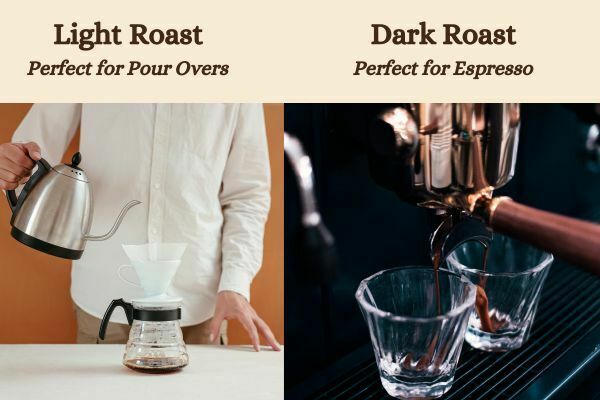The main difference between Light roast and dark roast coffee is that light roasts are roasted at lower temperatures for shorter period highlighting the natural, bright flavors of the coffee bean while dark roasts are roasted at higher temperatures for longer period which brings out deeper and richer flavors.

Coffee lovers, it’s time to shed some light on the dark side of roasting! From bright breakfast blends to inky espresso shots, roasting transforms those unassuming green beans into the lifeblood so many of us can’t live without.
I’ll discuss how time and temperature impact flavor and caffeine in light vs dark roasts. Look at the visual cues that signal a roast’s personality. And explore which brew methods make light roast shine versus bring out dark roast’s hidden depths.
The taste and flavors of Light vs Dark Roast
Dark roasts have a stronger and full-bodied taste with ashy and bitter undertones. You get the tasting notes of dark chocolates, toasted nuts, and hints of spice or smoke with a subtle bitterness. The longer roasting period also caramelizes more sugars, making dark roasts a little sweeter. Light roasts preserve more of the bean’s natural flavors and acids. They’re more acidic, so they give you a lively and tangy experience. You’ll taste vibrant notes like fruity, floral, and earthy.
If you enjoy a vibrant, acidic, and nuanced flavor profile, opt for a light roast and if you seek a strong and full-bodied coffee experience go with the dark roast.
appearance of Light and Dark Roasted Beans
Light roast beans are lighter in color, often a pale tan or light brown, and they retain more of their original shape and moisture.
These beans are typically dry and matte, with minimal oiliness on the surface.
Dark roast coffee beans have a much darker, almost black color. They appear shiny and oily due to the longer roasting process, which causes oils to rise to the surface.
Dark roast beans also have a more brittle texture, as they’ve lost more moisture during roasting.

Read a guide on 4 types of Coffee roasts
What Roast has more Caffeine content
Light roast coffee contains more caffeine by volume because the beans are denser compared to dark roasted beans that expand during the longer roasting process.
By volume means, one scoop of light roast grounds will have more caffeine than the same scoop of dark roast. This is because light roast beans are denser, so more grounds can fit in the same scoop size.
But by mass, they’re nearly equal, since caffeine degrades very little during roasting. Let’s say 25 grams of Light roast and 25 grams of Dark roast will have negligible differences in caffeine.
The caffeine content has more to do with the type and origin of coffee beans rather than the roast profile.
The Suitable Brewing Methods for Light and Dark Roast
If you want to get the best from light and dark roasts you must know that they require different approaches to highlight their unique flavors.
Lighter roasts, known for their fruity and floral qualities, benefit from a lower concentration (lower TDS) during extraction, allowing their delicate flavors to shine with clarity.
Methods like pour-over are ideal, since light roasts are denser and extract slowly – the gradual pour really sings!
Darker roasts develop nuttier, richer caramel flavors that require a stronger brewing method to bring out body and texture. Their expanded cellular structure extracts more rapidly too.
Espresso is a perfect match for dark roasts as it involves a shorter brewing time. The high pressure and fast extraction of espresso bring out the body, texture, and lingering aftertaste that are characteristic of dark roast profiles.
I love light roast pour-overs for a bright morning cup, then an intense dark roast espresso in the afternoon.

Brewing Tips for Light Roasts
Since lighter roasts extract flavors slowly due to their denser nature, these tips will help you make better coffee.
- Maintain a higher water temperature of around 205°F (Close to boiling) to extract more acids and aromatics
- Use a little finer grind size than normal to balance flavor clarity with body
- Use a lower coffee-to-water ratio of around 1:17 for a bright and delicate flavor
- Use slow and manual brewing methods like the pour-over method for gradual extraction
Brewing Tips for Dark Roasts
Dark roasts extract flavors more quickly and can make your coffee overly bitter. Here are some brewing tips for you to get the best out of dark roasts.
- To minimize the extraction of bitter flavors, make sure to maintain a lower water temperature at 190-195°F.
- Use a slightly coarser grind size for balanced extraction
- Use a Higher coffee-to-water ratio for more concentration
- Prepare coffee with strong brewing methods like Espresso and French Press to complement the full-bodied taste of dark roast.
Read a Guide on 14 Ways to Brew Coffee
The Roasting Process
Coffee cherries are harvested and then dried to remove moisture, which reduces their moisture content to around 10-12%.
After processing, the green coffee beans are loaded into a commercial roaster where they undergo the roasting process to transform into the delicious coffee beans that we enjoy every day.
To produce a light roast, coffee beans are rapidly heated to temperatures between 355 and 400 degrees Fahrenheit for a short period of time.
In light roasts, the beans reach the first crack in around 3-5 minutes. This produces light brown beans and preserves much of their inherent aroma.
After the first crack, a large portion of the coffee’s moisture is evaporated, and the beans grow in size.
Darker roasts require a longer roasting time, typically 8-15 minutes, and reach a temperature of around 430-440 degrees Fahrenheit.
The extended roasting process for darker roasts alters the bean’s cellular structure, removing acids and masking the origin profiles of beans while caramelizing the sugars, resulting in a deep, smoky flavor.
The beans also expand and become brittle due to the prolonged exposure to heat.
Read a Guide on White Coffee – The Extra Light Roasted coffee
What Roast is healthier
Moderate coffee consumption offers various health benefits, such as increased alertness, improved mood, and potential protection against certain diseases like Parkinson’s and Type 2 diabetes.
It’s also a source of essential antioxidants and polyphenols, which can contribute to better health and well-being.
Light roasts are considered healthier than dark roasts since they preserve more of the antioxidants and polyphenols that degrade when exposed to hot temperatures for extended periods. But due to pronounced acidity light roasts may not be a perfect choice for those having stomach issues.
According to a study:
“Polyphenol content and antioxidant activity were found to depend both on the coffee’s origin and degree of roasting. Longer roasting times resulted in greater polyphenol degradation.”
Final Thoughts
After diving into the delicate dance between light vs dark roasts, I’ve gained a deeper appreciation for both ends of the coffee flavor spectrum.
Here, I summarize the Pros and Cons of Dark roasts
✔️ Strong and Full bodied cup of coffee
✔️ Offer very enticing aroma
❌ They lose some of the coffee’s natural goodness
❌ Your drink can get bitter
And the Pros and Cons of Light Roasts
✔️ Offers brighter acidity and fruitier notes
✔️ They preserve more antioxidants, making them the healthier option
❌ Can taste underdeveloped or hollow
❌ Acidity can be too sharp or sour for some drinkers
I’d love to hear in the comments what your favorite roasts and brewing methods are, light or dark.
Check Out Related articles:



